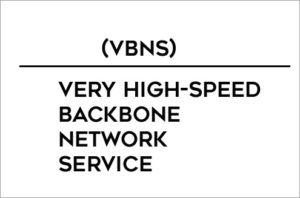
Date: 01/01/1995The very high-speed Backbone Network Service (vBNS) came on line in April 1995 as part of a National Science Foundation (NSF) sponsored project to provide high-speed interconnection between NSF-sponsored supercomputing centers and select access points in the United States. The network was engineered and operated by MCI Telecommunications under a cooperative agreement with the NSF.
NSF support was available to organizations that could demonstrate a need for very high speed networking capabilities and wished to connect to the vBNS or later to the Abilene Network, the high speed network operated by the University Corporation for Advanced Internet Development (UCAID, which operates Internet2).
By 1998, the vBNS had grown to connect more than 100 universities and research and engineering institutions via 12 national points of presence with DS-3 (45 Mbit/s), OC-3c (155 Mbit/s), and OC-12c (622 Mbit/s) links on an all OC-12c, a substantial engineering feat for that time. The vBNS installed one of the first ever production OC-48c (2.5 Gbit/s) IP links in February 1999, and went on to upgrade the entire backbone to OC-48c.
In June 1999 MCI WorldCom introduced vBNS+ which allowed attachments to the vBNS network by organizations that were not approved by or receiving support from NSF. The vBNS pioneered the production deployment of many novel network technologies including Asynchronous Transfer Mode (ATM), IP multicasting, quality of service, and IPv6. After the expiration of the NSF agreement, the vBNS largely transitioned to providing service to the government. Most universities and research centers migrated to the Internet2 educational backbone.
In January 2006 MCI and Verizon merged. The vBNS+ is now a service of Verizon Business.
What is the vBNS?
vBNS stands for very high performance Backbone Network Service.
The vBNS is a nationwide network that operates at a speed of 622 megabits per second (OC12) using MCI’s network of advanced switching and fiber optic transmission technologies. At speeds of 622 megabits per second, 322 copies of a 300-page book can be sent every seven seconds.
Launched in April 1995, the vBNS is the product of a five-year cooperative agreement between MCI and the National Science Foundation (NSF) to provide a high bandwidth network for research applications.
How does the vBNS work?
The vBNS relies on advanced switching and fiber optic transmission technologies, known as Asynchronous Transfer Mode (ATM) and Synchronous Optical Network (SONET). The combination of ATM and SONET enables very high speed, high capacity voice, data, and video signals to be combined and transmitted “on demand”.
The vBNS’ speeds are achieved by connecting Internet Protocol (IP) through an ATM switching matrix, and running this combination on the SONET network.
Who can use the vBNS?
The vBNS was designed for the scientific and research communities and originally provided high speed interconnection among NSF supercomputing centers and connection to NSF-specified Network Access Points. Today the vBNS connects two NSF supercomputing centers and research institutions that are selected under the NSF’s high performance connections program.
The vBNS is only available for meritorious research projects with high bandwidth uses and is not used for general Internet traffic.
Since MCI owns and operates the network, can MCI determine who connects to the vBNS?
No. The NSF awards grants under its high performance connection program. MCI is not involved in the program or the decision process. For more information on the NSF’s high performance connections program, contact:
What is the difference between the vBNS and the Internet?
The Internet is a ubiquitous network that has become an information tool for researchers, students, teachers, business and the general public. The vBNS is a non-commercial research platform for the advancement and development of high speed applications, data routing and data switching capabilities.
What is the relationship between vBNS and Internet2?
Through the NSF’s high performance connections program, fifty-three Internet2 university members have received grants to support the acquisition of high performance network connections to the vBNS. Internet2 members will use the vBNS to enable the advanced, networked computing applications they are developing. The vBNS serves as initial interconnect for Internet2 members.